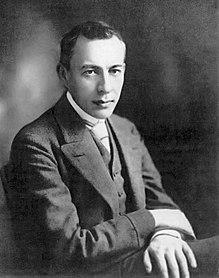
Six moments musicaux (French for "Six Musical Moments"; Russian: Шесть музыкальных моментов, romanized: Shest’ muzykál’nykh moméntov), Op. 16, is a set of solo piano pieces composed by the Russian composer Sergei Rachmaninoff between October and December 1896.[1] Each Moment musical reproduces a musical form characteristic of a previous musical era. The forms that appear in Rachmaninoff's incarnation are the nocturne, song without words, barcarolle, virtuoso étude, and theme and variations.[2]
The individual pieces have been described as "true concert works, being best served on a stage and with a concert grand."[3] Although composed as part of a set, each piece stands on its own as a concert solo with individual themes and moods.[2] The pieces span a variety of themes ranging from the funeral march of number three to the canon of number six, the Moments musicaux are both Rachmaninoff's return to and revolution of solo piano composition.[3] A typical performance lasts 30 minutes.[2][4]
In an interview in 1941, Rachmaninoff said, "What I try to do, when writing down my music, is to make it say simply and directly that which is in my heart when I am composing."[5][6] Even though Moments musicaux were written because he was short of money,[7] the pieces summarize his knowledge of piano composition up to that point.[1] Andantino opens the set with a long, reflective melody that develops into a rapid climax.[7] The second piece, Allegretto, is the first of the few in the set that reveal his mastery of piano technique.[8] Andante cantabile is a contrast to its two surrounding pieces, explicitly named "funeral march" and "lament."[1][9] Presto draws inspiration from several sources, including the Preludes of Frédéric Chopin, to synthesize an explosion of melodic intensity.[1] The fifth, Adagio sostenuto is a respite in barcarolle form, before the finale Maestoso, which closes the set in a thick three-part texture.[8][6]
- ^ a b c d Harrison, Max (2006). Rachmaninoff: Life, Works, Recordings. London: Continuum. pp. 72–73. ISBN 0-8264-9312-2. Text at Google Books.
- ^ a b c Angela Glover (2003). "Moments musicaux, Op. 16". An Annotated Catalogue of the Major Piano Works of Sergei Rachmaninoff (Ph. D. treatise). Florida State University. pp. 9–15. Retrieved 2019-05-05.
- ^ a b Wolff, Elizabeth (January 2004). "Elizabeth Wolff: 19th century classical piano". Magnatune.com. Retrieved 2007-09-10.
- ^ Brisson, Eric (2007). "Rachmaninov – Moments musicaux (6), op.16". Pianopedia. Retrieved 2007-08-19.
- ^ Original in Russian: „Единственное, что я стараюсь делать, когда я сочиняю, это заставить ее прямо и просто выражать то, что у меня на сердце.“
- ^ a b "Mussorgsky/Rachmaninov – Pictures at an Exhibition/6 Moments musicaux". Pristine Classical – Lilya Zilberstein CD (Liner notes). 2004. Retrieved 2007-09-16.[dead link]
- ^ a b Matthew-Walker, Robert (1994). The Complete Piano Music of Sergei Rachmaninov played by Howard Shelley. Nimbus Records Limited. Liner notes.
- ^ a b Darrell, R. D. (1977). Piano Music of Rachmaninoff (liner notes). Vox Box.
- ^ Hancock, Robin James (1992). Rachmaninoff's Six moments musicaux, Op. 16, and the Tradition of the Nineteenth-Century Miniature (dissertation). Boston University. OCLC 48147852.